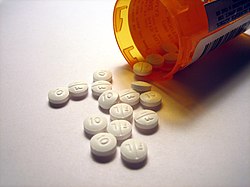Last Friday, I was on the Medicare Part D(rugs) web site (which itself is possibly a conspiracy to break the spirit of the elderly and disabled, and make us give up on life) tabulating my medications and their costs. While crunching the numbers, I found that (as Mom had faced when I was living at home) the antidepressant Lexapro was the biggest expense, totaling over half the monthly Nick prescription costs!! Lexapro is $134.92 and, because it’s a brand name antidepressant, Medicare Part D will always make you pay 50%, or $67.46, per month!
I did some research on how this burden can be alleviated. Here’s what I learned: no generic Lexapros are available because Forest Laboratories, Inc. got a judge to extend their patent (I wonder how they’d defend that). No generic versions will be able to compete on the market until March 14, 2012.
Further, I learned the single enantiomer or enantiopure drug game is (often) one ploy out of many to “evergreen” drugs A HUGE SCAM.

In the case of Lexapro, they had a drug, Celexa (citalopram), and its patent ran out in 2003, opening it to generic competition. So they stripped out only the active molecule in Celexa, creating the enantiopure drug escitalopram, and then marketed it as A NEW DRUG, Lexapro! Lexapro is simply the active ingredient in Celaxa! It’s essentially the same drug! IT’S THE SAME ACTIVE INGREDIENT! Forest Laboratories has always CLAIMED that the new Lexapro with only the single active molecule is more effective than Celexa, and their marketing convinced many doctors of this (and then doctors convinced credulous patients). This, despite the fact that most independent studies show Celexa is just as effective as Lexapro in most cases (source.
Celexa’s patent expired in ’03, but they’ve been able to keep the profits rolling in by slightly modifying it and selling it as a new drug. Within the industry this is one way of “evergreening” drugs.
This video from Doctors Without Borders gives a quick rundown of the evergreening problem in light of India v. Novartis, a court battle over the manufacture of generic chemotherapy meds.
The FDA, the gov’t agency that regulates medications and their marketing (including the nonstop TV ads; “ask your doctor about Ultron!”), decided to open the floodgates to enantiopure drugs, merited and questionable medicines alike. That the regulators allow single enantiomers and other derivative medicines to be marketed as a wholly new drug, not Celexa Plus or something, means the government is an active accomplice in misleading billions (the U.S. pharma industry supplying world markets). It is a serious travesty.
This scam works so well, and has pulled thousands from countless families, because, like the very best marketing ploys, it’s got that kernel of truth, that nucleus of realness at the center of the electron cloud of B.S.. The “rawer” compound, or racemic mixture, may be a-okay if we’re talking albuterol (also called Salbutamol in international markets) vs. the enantiopure drug Xopenex, especially if you’re accustomed to the side effects of the “whole enchilada” compound, albuterol (brand name Ventolin®).
But do you want to roll the dice on the double-barreled racemic mixture when it’s something uber-delicate like SSRI meds and you don’t know how the right-barrel (“inactive” right-enantiomer) will sit with ya? Feelin’ lucky?
Obviously there have to be tests and clinical trials on the single enantiomer vs. racemic mixture, not an inexpensive undertaking, since in some cases separating the stereoisomers is effectively impossible (Thalidomide is racemic: the enantiomers convert into each other in the body, so its adverse effects can’t be separated out), essential (Naproxen is an effective anti-inflammatory medicine, once its super poisonous enantiomer is removed) or counterproductive (Penicillin only acts against bacteria with both enantiomers intact; it is “stereodependent”).
Not all medicines are as simple as stereoisomers either. A lot of overhead is needed to test drugs. But increasingly, Big Pharma is selling S-enantiomer meds when the enantiopure drug, while more potent, does not strip out real adverse effects or confer other meaningful benefits. The antacid Nexium is probably the most infamous example, a new brand with no clinical benefits, pressed forth with skewed research that (admittedly in the fine print) compared the benefits of 20mg and 40mg Nexium against 20mg capsules of its racemic predecessor Prilosec, just for “evergreening” purposes.
PROTECT YOUR FAMILY from these ploys!
Here is a list of “new” meds that are just the active ingredient (single enantiomer) of older meds! Whenever possible (and safe) to do so, don’t buy the “new” version, get an older generic with the same ingredient, and save your money!
| Racemic Mixture | Single Enantiomer |
|---|---|
| Amphetamine (Benzedrine) | Dextroamphetamine (Dexedrine) |
| Ritalin | Focalin |
| Celexa | Lexapro |
| Provigil | Nuvigil |
| Floxin | Levaquin |
| Prilosec | Nexium |
| Albuterol | Xopenex |
| Imovane | Lunesta |
Source: Single-enantiomer drugs
Talk to your doctor about switching to lower-cost generics. You could be receiving the same clinical benefits at a fraction of the cost!
PROTECT YOURSELF!! It seems the government is in the pocket of moneyed interests and won’t protect us from these scams.
Nick
Related Bloggery:
Scott’s Web Log: Evergreening Does Not Refer to Trees
